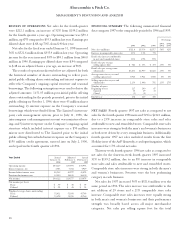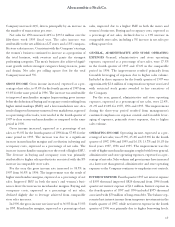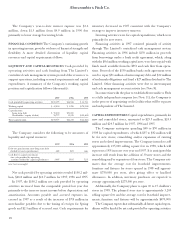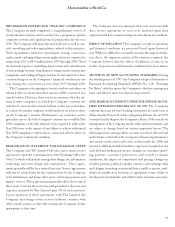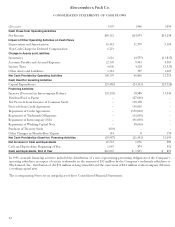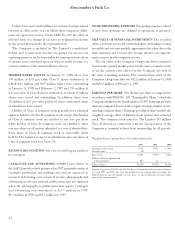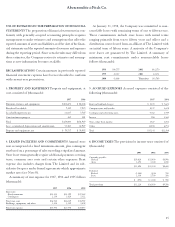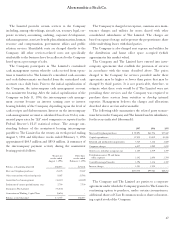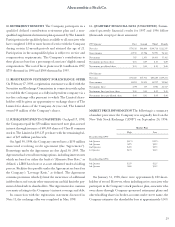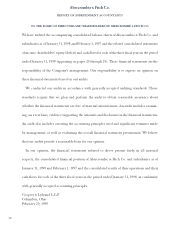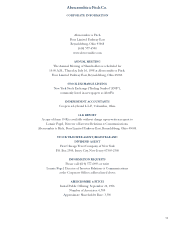Abercrombie & Fitch 1997 Annual Report Download - page 18
Download and view the complete annual report
Please find page 18 of the 1997 Abercrombie & Fitch annual report below. You can navigate through the pages in the report by either clicking on the pages listed below, or by using the keyword search tool below to find specific information within the annual report.
26
Abercrombie &Fitch Co.
A reconciliation between the statutory Federal income tax
rate and the effective income tax rate follows:
1997 1996 1995
Federal income tax rate 35.0% 35.0% 35.0%
State income tax, net of Federal
income tax effect 4.7% 4.7% 5.2%
Other items, net 0.3% 0.2% (0.3)%
40.0% 39.9% 39.9%
Income taxes payable included net current deferred tax assets
of $2.3 million and $1.2 million at January 31, 1998 and
February 1, 1997.
Current income tax obligations are treated as having been set-
tled through the intercompany accounts as if the Company were
filing its income tax returns on a separate company basis. Such
amounts were $27.6 million, $10.6 million and $7.5 million in
1997, 1996 and 1995.
The effect of temporary differences which give rise to
net deferred income tax assets was as follows (thousands):
1997 1996
Depreciation and amortization $1,540 $1,480
Rent 1,510 (413)
Accrued expenses 3,450 1,343
Other, net (450) 683
Total deferred income taxes $6,050 $3,093
No valuation allowance has been provided for deferred tax
assets because management believes that it is more likely than
not that the full amount of the net deferred tax assets will be
realized in the future.
7. LONG-TERM DEBT Long-term debt consists of a 7.80%
unsecured note in the amount of $50 million that matures May
15, 2002, and represents the Company’s proportionate share of
certain long-term debt of The Limited. The interest rate and
maturity of the note parallels that of corresponding debt of
The Limited. The note is to be automatically prepaid concurrently
with any prepayment of the corresponding debt of The Limited.
8. RELATED PARTY TRANSACTIONS Transactions between
the Company, The Limited, and its subsidiaries and affiliates
commonly occur in the normal course of business and principally
consist of the following:
Merchandise purchases
Real estate management and leasing
Capital expenditures
Inbound and outbound transportation
Corporate services
Information with regard to these transactions is as follows:
Significant purchases are made from Mast, a wholly-owned
subsidiary of The Limited. Purchases are also made from
Gryphon, an indirect subsidiary of The Limited. Mast is a con-
tract manufacturer and apparel importer while Gryphon is a
developer of fragrance and personal care products and also a
contract manufacturer. Prices are negotiated on a competitive
basis by merchants of the Company with Mast, Gryphon and
the manufacturers.
The Company’s real estate operations, including all aspects
of lease negotiations and ongoing dealings with landlords and
developers, are handled centrally by the Real Estate Division of
The Limited (“Real Estate Division”). Real Estate Division
expenses are allocated to the Company based on a combination
of new and remodeled store construction projects and open
selling square feet.
The Company’s store design and construction operations
are coordinated centrally by the Store Planning Division of
The Limited (“Store Planning Division”). The Store Planning
Division facilitates the design and construction of the stores and
upon completion transfers the stores to the Company at actual
cost. Store Planning Division expenses are charged to the
Company based on a combination of new and remodeled store
construction projects and open selling square feet.
The Company’s inbound and outbound transportation
expenses are managed centrally by Limited Distribution
Services (“LDS”), a wholly-owned subsidiary of The Limited.
Inbound freight is charged to the Company based on actual
receipts, while outbound freight is charged on a percentage of
cartons shipped basis.


